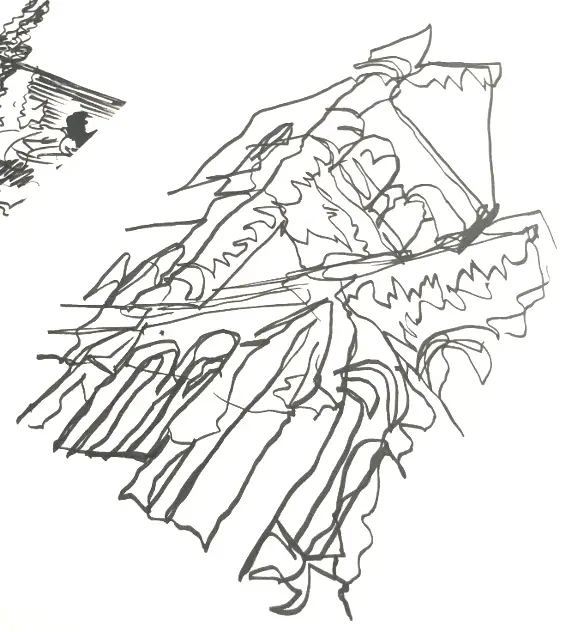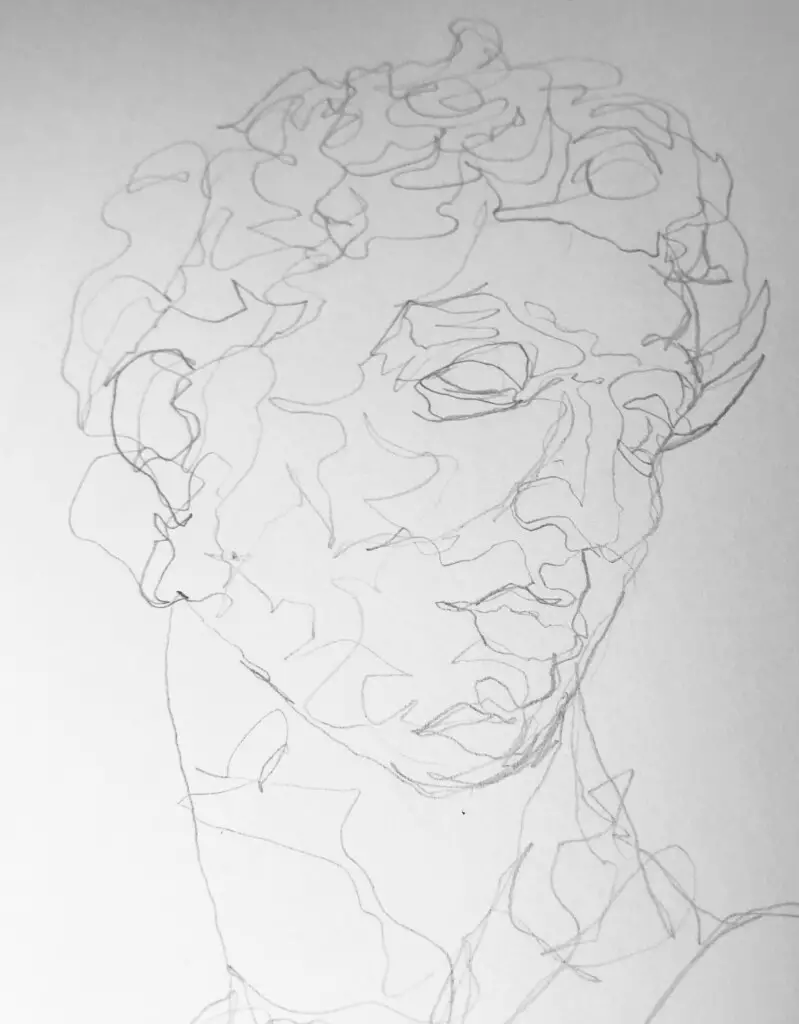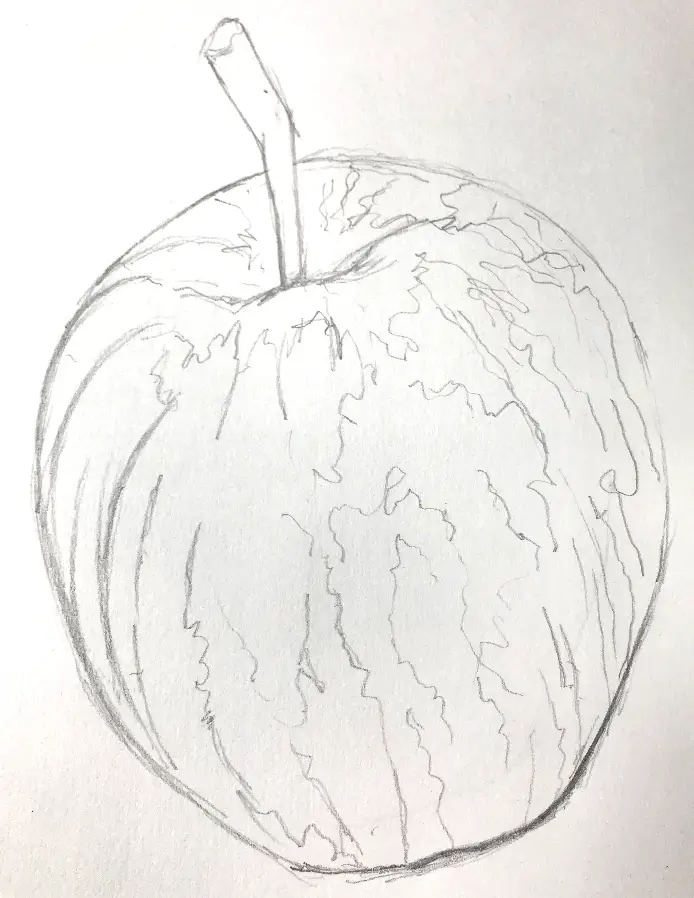What is a Contour Line Drawing?
The art of drawing is arguably the simplest and the most effective way for artists to express themselves. As a great communication tool, drawing offers an artist way to express their thoughts and feelings.
Whether you are an established artist or an ardent art lover, drawing is something that will always continue to have an influence on your life. It helps to stimulate creative thoughts, enhances observational skills, and allows artists to develop visual artwork ideas in all mediums.
Please look at this drawing and sketching video course I have created. Use this link.
There are potentially endless types of drawing that involve diverse materials and techniques. And one of these drawing techniques is contour drawing. From the time we are young children, we all grab pencils, books and start scribbling some shapes.
But what most people don't realize is that at one point, we were all aspiring contour artists!
Contour drawing is a highly essential technique in art because it is the foundation of drawing. It is widely regarded among art schools as arguably the most effective discipline for any beginner artist.
In the hands of an experienced artist, contour lines can be used to deliver an astonishing amount of visual appeal. But what is contour line drawing in art?
A contour drawing refers to an object or model outline without any shading, tone, or texture. Contour drawings only consist of lines and have very little detail.
For instance, you were to draw an apple, you would only draw a round shape and a stem. You wouldn't include the bruises, scratches, or wormholes.
What's more, you wouldn't include color variations and highlights. Just pure lines! Regarded as one of the most basic drawing techniques, contour drawing is what most budding artists learn in their journey to becoming top artists.
Even though contour drawing is quite simple and straightforward, its potential benefits are enormous. Remember that most artists learn drawing through contour drawing. From the moment you pick up a crayon and try to reproduce shapes, straight lines, or circles, you are primarily starting your artistry journey.
Over time, you'll master how to keep your hands steady as you draw. You'll also learn how to combine various lines and shapes to make the desired objects or forms.
Contour drawing brings you back to your art basics because it forces you to view objects in their simplest forms. Without emphasizing all the details of whatever you are drawing, contour drawing allows you to practice the basics of art and view objects differently in terms of their shapes.
It is incredible how your ability to draw lines and shapes can significantly enhance your drawing when you don't focus on shadings, colors, and details.
You Also May Like:
- What is the Difference Between Blind Contour and Contour Line Drawing?
- Drawing with Lines and Shapes
- Easy Contour Drawing Ideas
- How to Draw Without Looking at the Paper
Types of Contour Line Drawing?
There are several types of contour line drawings, but the most popular and most used include:
* Contour Drawing: A contour is simply a line that defines an object's edge or form. As earlier explained, the contour drawing technique is where most aspiring artists start by simply learning how to draw the shape's visible edges.
Contour lines describe the outermost edges of an object and the plane's dramatic changes in form.
* Blind Contour Lines: This is strikingly similar to a regular contour drawing except that here, you are keeping your eyes on the object you are drawing without looking at the drawing paper.
Also, ensure the tip of your pen or pencil is in contact with the paper at all times. So that you don't get lost. The objective is to ensure you are drawing what you see but not what you might be seeing.
* Cross Contour Lines: Just as the name suggests, cross contour lines are drawn lines that travel across the form. Cross contour lines may be vertical or horizontal, or both. On most occasions, cross contour lines are drawn at varying angles.
Cross contours follow the surface area's form, using curved lines, spherical planes, and straight lines across flat surfaces.
Contour Drawing:
A contour drawing happens when the artist comprehensively looks at the object's edges but rarely stares at the drawing paper as the pencil moves.
The objective of contour drawing is to create a true and authentic line to what you see and boost your hand-eye coordination.
A contour drawing shows the outlines, edges, and shapes of an object but omits color, tone, surface texture, and other fine details.
Contour is usually described as the outline of a body or figure. However, it is imperative to note that there is a slight difference between an outline and contour.
To be more precise, an outline is a two-dimensional diagram.
It is the sort of thing you create when you place your feet on a flat piece of paper and trace around your toes with a pencil, just a simple representation of the main object.
On the other hand, a contour drawing boasts a three-dimensional quality. That is to say that it indicates the length and thickness, and width of the form it represents.
The illusion of three-dimensional form in contour drawing is often achieved by varying the lines' weight, using relatively darker lines in the foreground and paler lines in the background.
The contour drawing technique allows you to focus all your attention on the model rather than the usually divided effort of staring alternatively at the model and paper.
For this reason, you can effectively follow and implicate forms to their most logical conclusion and learn how and where they relate to other forms.
The experience of staring at the reference object is not restricted by looking at the drawing paper, your drawing comes out as a truthful representation of the object.
Blind Contour Drawing:
Just as the name implies, blind contour drawing refers to when the contour is drawn without looking at the paper at all! The purpose of blind contour drawing is to train you to always look at the object you are drawing than at your drawing paper.
A blind contour drawing simply means that you draw blind and draw an object without ever staring at your pencil or paper. With this type of drawing technique, an artist spends 100% of his time staring at the object he is trying to draw and zero percent of his time on the paper.
You simply go about the entire drawing process without ever looking at your paper.
It is a great drawing exercise that not only boosts your eye-coordination prowess but helps you to understand that representational drawing is all about been a keen observer.
Without superb observation skills at your disposal, you are almost lost as an artist. To help you understand how important blind contour drawing is, consider this scenario:
Let us assume you are trying to draw a picture of a cup sitting in front of you. You will regularly move your eyes from the cup to the paper as you try to get the shapes right. During all this process, your eyes are simply trying to make sense of how the cup in front of you looks.
Focus on the shape and size. Ensure the picture is exactly the same as the cup. This can be pretty exhausting!
With blind contour drawing, your eyes only focus on the object, while your hands focus on the paper and the pencil's movement.
This instills a more natural and instinctive sense of the size and shape of the object you are trying to draw, and this means you are typically drawing what you see.
Cross Contour:
In simple terms, cross contour lines reflect the movement of your eye in and around the object you are seeing. Whereas general contour lines describe edges on an object, cross contours describe volume and form.
Cross contour lines can follow planes of form, moving across or around objects and through them. In cross contour drawing, lines represent the dips, curves, values, turns, and bumps of the objects you are trying to draw.
There is a great benefit of knowing and understanding cross contour drawing. This technique helps you communicate form in your drawings and paintings and helps you make informed or intelligent decisions regarding the direction of your lines, whether it be with a brush, pen, or pencil.
Even though cross contour lines can generally flow in any direction, on most occasions, nearly all experienced artists agree that horizontal lines are the best. That is, those that are at the right angle to the outside edge.
However, sometimes, it can be helpful to incorporate vertical contour lines into your drawings, such as those that run from the collar bone down to the chest, the pelvic region, and the ribs. Basically, you are only using interior lines to depict the tone, value, and shape of a particular object.
Cross contour drawing is a great way to boost your observational skills, and this implies that when you eventually start to shade, your mark-making will be superb and much more believable. Cross contouring exercises will help you to understand the complexities of how different objects are shaped.
Cross contour drawing allows you to understand that a shape is more than just an outline. You know that a cup dips in the center, but how deep does it go? You also know that a ball is round, but how round is it?
If you fail to interpret these features correctly, the chances are high that you'll end up with an inferior drawing and a false representation of the object you are trying to draw.
Line Drawing:
This simply involves creating illustrations using primary lines of varying angles and weight to demonstrate depth and form. It does not include gradient or shading but only focuses on lines.
Inline drawing, you are simply translating your real-life experiences into a two-dimensional visual report.
Most people usually think of lines as simple marks that connect two points! It is imperative to note that lines can be descriptive, two-dimensional, three-dimensional, or implied. Simply put, lines can be manipulated to achieve the desired form and shape.
While there are numerous lines in art drawing, there are several techniques in a line drawing that you can use to create tone in a drawing, ranging from cross-hatching, hatching, stippling to scribbles and using small crosses or circles.
So, even though line drawing may be viewed as basic or elemental, artists can use it in various techniques to show their creative side.
So, what is the difference between blind contour drawings and modified contour drawings?
As we have already explained, blind contour drawing occurs when contour drawing is carried out without staring at the paper. You are only focusing your eyes on the object you are trying to draw, with zero attention to the drawing material or paper.
This type of contour drawing's primary objective is to help connect your eyes, hand, and brain and allow you to draw precise and accurate pictures that are true representations of the form.
On the other hand, with a modified contour drawing, you can look at the drawing paper 10% while focusing on the object in question 90% of the time. To be more precise, you only stare at your paper when placing your pen or pencil on the paper to start a new line.
You are allowed to take a glance at your drawing board just to ensure you aim at the right spot.
Modified contour drawing can prove handy to beginner artists, as it allows them to get instant feedback about what they are doing. Most of the time, you are only looking at the object you are drawing using your instincts and observational skills.
But by looking down at the paper a few times, you can actually realize where you went wrong as you continue to draw.
With blind contour drawing, you may never be able to identify any problem until you are done. Simply put, modified contour drawing allows you to correct a particular issue as you proceed with your drawing.
The Bottom Line:
Whether you are a professional artist or an amateur artist, contour drawing can significantly boost your artistry. While it might seem absurd at first, contour drawing can be an excellent way to improve your eye-hand coordination, which is the basis of art drawing.
It not only trains you how to indeed observe an object but forces you to fully trust your hands! There are many contour drawing techniques that you can incorporate into your art world to help take your drawing abilities to a whole new level.
Create Art With My Favourite Drawing Resources
General Drawing Courses. I like Udemy if you want to develop your knowledge of drawing techniques. Udemy is an excellent choice due to its wide range of creative courses and excellent refund policy. They often have monthly discounts for new customers, which you can check here. Use my link.
Sketching and Collage. Take a look at this sketching resource I have created. Use this link.
Proko. Is one of my favorite teachers who surpasses in the teaching of Anatomy and Figure drawing. Prokos course breaks down the drawing of the human body into easy-to-follow components aiding the beginner to make rapid progress. For this, I really like Proko.
Art Easels. One of my favorite ways to draw is by using a drawing easel, which develops the skill of drawing on a vertical surface. The H frame easel is an excellent vertical way to add variety to the style and type of marks you create when using a drawing board.
To see all of my most up-to-date recommendations, check out this resource I made for you.




